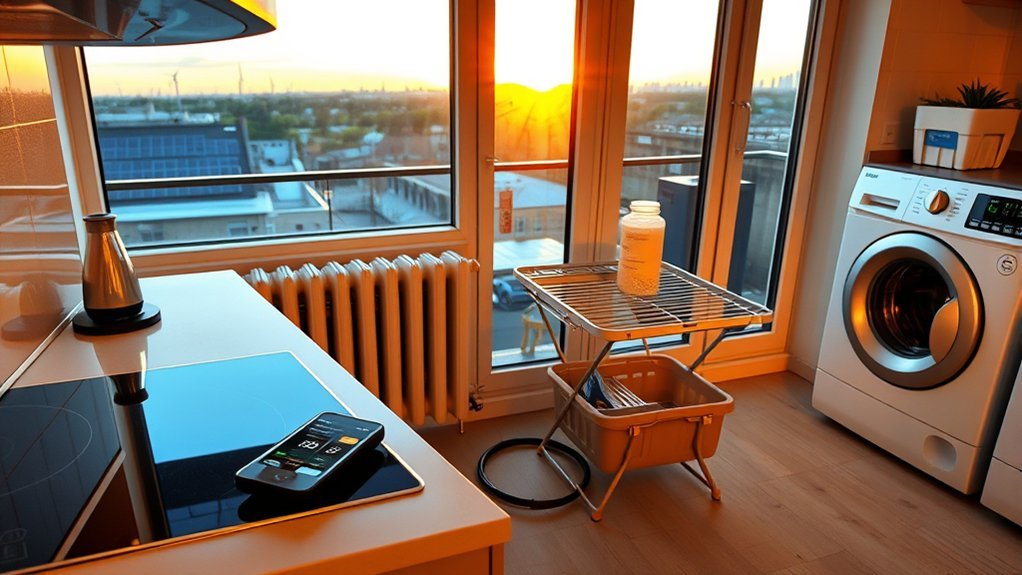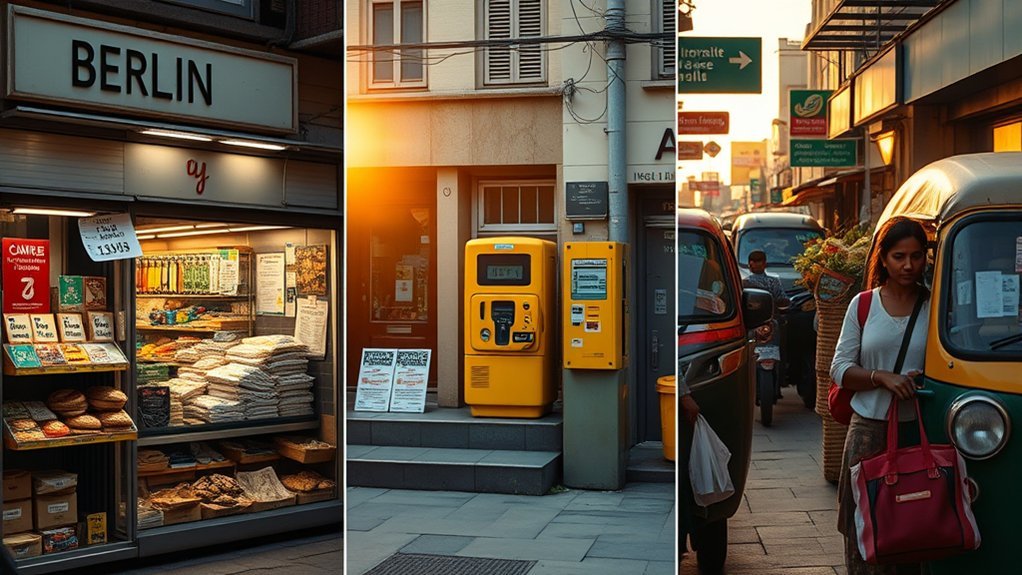You’ll typically need about €2,846 per month (€34,152/year) to live in Germany as an average household, with housing, utilities, food and transport included. Rent varies widely: expect around €892 for a one‑bedroom in major cities, €1,436 in Munich, €1,220 in Berlin and as low as €486 in smaller towns. Utilities, telecoms and transit add several hundred euros monthly. Health insurance is mandatory and can affect budgets—keep reading for detailed city, student and itemized breakdowns.
Average Monthly and Annual Living Costs in Germany (2025)

Although costs vary by region, you can expect the average private household in Germany to spend about €2,846 per month (€34,152 yearly) as of April 2025.
Although regional variation exists, the average German private household spends about €2,846 monthly (€34,152 yearly) as of April 2025.
You’ll find the average monthly cost of living broken down: housing expenses (including utilities in Germany) average €1,025, while food and drink costs sit at €417.
Transportation costs average €347, covering public transport — for example the Deutschland-ticket at €58 — and car-related expenses.
Health insurance cost and toiletries contribute roughly €118 monthly; clothing is about €103.
These specific line items show how costs of living add up and why regional variations matter: living costs in major German cities tend to push average rent and total monthly expenses higher, whereas rural areas reduce them.
If you’re comparing budgets, use these benchmarks to calculate net income needs and discretionary spending, and adjust for city-specific premiums or lower rural cost structures.
Housing and Rent: What to Expect by City and Region

Now that you’ve seen average household spending, look next at how housing drives much of that total: rent varies dramatically by city and region, so where you live can change your monthly budget by several hundred euros.
Rent prices for a one-bedroom apartment in major cities average about €892, but regional differences shift that figure sharply. Munich tops the list: expect roughly €1,436 in the city center. Berlin is lower yet still high for Germany, near €1,220 for a small one-bedroom. Southern cities such as Stuttgart also push averages upward.
By contrast, smaller cities and eastern centers like Leipzig, Dresden and Saarbrücken offer affordable options—Saarbrücken can be as low as €486 for similar units. Outside city centers typical one-bedroom rents range €430–€1,218, so choosing suburbs or smaller cities materially reduces living expenses.
When planning housing, compare city center premiums against commuter options to optimize your budget.
Utilities, Telecoms, and Recurring Household Expenses

While housing often dominates conversations about cost of living, recurring household expenses — utilities, telecoms and insurance — can add several hundred euros to your monthly outlay and vary widely by consumption and location.
You should budget the average monthly cost for utilities at about €303.85 for an 85m² apartment, noting a range from €200 to €493 driven by energy use and region.
For telecoms, mobile phone plans with ≥10GB typically run €25.67 (€10–€39.95), while internet plans of 60 Mbps+ average €45.24 (some from €35).
Insurance costs are modest per-policy: basic policies for home contents (Hausratversicherung) start under €3.40/month; building insurance for ~100 m² begins near €14.72/month.
Adding these recurring costs shows utilities dominate total household expenses, but telecoms and insurance still shift your monthly budget.
Compare local energy prices and choose internet and mobile plans to control overall household expenses and reduce unexpected spikes.
Food, Groceries, and Dining Out Prices

You’ll find common grocery items like 500g white bread at about €1.91, 1L milk at €1.10 and 1kg chicken fillet around €12.76, which helps frame average monthly food costs of roughly €150–€250 depending on shopping habits and choice of stores.
Eating out ranges from cheap options such as a doner for ~€15 to a mid-range meal for two at ~€65, with coffees and beers averaging €3.43 and €4.30 respectively.
To save, you can rely on discount chains (Lidl, Aldi), university Mensa meals (~€10–€15) and limiting restaurant visits that can push monthly food spending toward €150–€200.
Typical Grocery Item Costs
Groceries in Germany are generally affordable compared with many Western countries: students typically spend €150–€250 per month and can cut costs by shopping at discount chains like Lidl or Aldi, where staples such as 500g white bread (€1.91), 1L milk (€1.10) and 1kg chicken fillet (€12.76) are common price points.
You’ll find grocery item prices consistently lower at discount supermarkets, helping keep your average monthly grocery costs within student budgets. Typical grocery items like bread, milk and poultry form the bulk of basic living expenses in Germany.
For context, a mid-range meal for two is around €65 and a fast-food meal under €10, while beverage prices (0.5L beer €4.30, cappuccino €3.43) and Mensa meals (€10–€15 with student discounts) further inform choices.
Eating Out Price Ranges
How much you spend eating out in Germany depends on where and how often you dine: a mid-range dinner for two averages about €65, a cheap fast-food option like a döner runs around €15, and a pub beer costs roughly €4.30 while a cappuccino is about €3.43.
You’ll compare dining costs across venues: mid-range meal vs cheap fast food, university cafeterias (Mensa) offering €10–€15 meals, and varied restaurants.
Budget decisions tie to grocery expenses—students see €150–€250 monthly—and basic item prices like milk at €1.10/liter or eggs €3.22/dozen.
Public transport monthly passes (~€58) expand access to dining venues. If you’re a student, check for student discounts at Mensa and selected restaurants to shift per-meal averages lower.
Saving on Food Expenses
Because shopping habits and meal choices directly shape your monthly food bill, students who buy at discount supermarkets like Lidl or Aldi and cook most meals at home can keep grocery costs near €150–€250.
In contrast, routinely eating out where a mid-range dinner for two averages €65 and a cheap doner runs about €15. You’ll cut costs further by using student discounts and choosing dining at university canteens where meals often cost €10–€15.
Track food prices: white bread ~€1.91/500g, milk ~€1.10/L, and prioritize budget-friendly meal planning to protect your monthly budget.
Compare unit prices, plan weekly menus, and swap occasional restaurant meals for home-cooked ones to maximize savings on food expenses and stretch limited student funds.
- Relief: small changes lower stress fast.
- Pride: mastering grocery costs feels empowering.
- Freedom: extra cash boosts options.
Transportation, Insurance, and Other Regular Costs

You’ll find monthly transportation averages around €347, split roughly €33 for public transit and €314 for car-related costs.
So compare the Deutschlandticket (€58/month) against driving if you commute regularly.
Health insurance is mandatory and varies by status—students pay about €110/month in public plans, while professionals’ premiums depend on income—so factor that into monthly budgets.
Add utilities (~€304 for an 85m² flat), annual car insurance (~€250), registration (~€30), and fuel (€72–€106/month) to get a precise view of recurring expenses.
Public Transit and Fares
While city-to-city prices vary, Germany’s public transit is generally the cheapest practical option: the Deutschlandticket costs about €58 per month and replaces multiple €3 one-way fares in many trips.
Students can cut costs further with semester tickets of roughly €150–€300 per year. You’ll find public transportation reduces transportation expenses compared with car ownership expenses, which average about €314 monthly (insurance, fuel, maintenance).
At gasoline prices near €1.75/l, driving becomes significantly more expensive for daily commutes. Choosing the Deutschlandticket lowers your monthly cost volatility and simplifies budgeting; local transport tickets still make sense for occasional riders.
Students gain the largest proportional savings via semester tickets, while commuters should compare frequency and distance to decide.
- Relief: predictable monthly cost eases budgeting.
- Frustration: occasional long-distance trains aren’t covered.
- Empowerment: clear savings versus car ownership.
Health and Care Insurance
After you pick a transport strategy, the next regular cost to quantify is health and care insurance, which all residents must carry.
Health insurance is mandatory: public insurance premiums average around €110 monthly for students in student accommodation, while working professionals pay contributions tied to gross salary (with assessment capped at €5,512.50 monthly).
Your monthly cost will vary—average cost for employed individuals typically equals a percentage split between employer and employee, making public insurance generally predictable.
Private insurance can be cheaper or more expensive depending on age, income and coverage needs, but it shifts risk and administration to you.
When budgeting monthly expenses, treat health insurance as a fixed, legally required item rather than optional discretionary spending.
Car Ownership Costs
Car ownership in Germany typically costs around €314 per month when you include fuel, maintenance and registration, making it particularly more expensive than using public transit—an Deutschlandticket runs €58 monthly.
You’ll find car ownership costs driven by gasoline prices (~€1.75/L), routine maintenance, and modest registration fees (~€30/year). Annual car insurance in Germany averages about €250, though your premium depends on profile and coverage.
Compare the average monthly cost of a personal vehicle ownership to public transport options: transportation costs for a car often exceed combined ticket and incidental costs for many commuters.
If you value predictability, public transit is a clear, cost-effective alternative to reduce monthly expenses.
- You might feel relieved saving €256/month.
- You could miss door-to-door freedom.
- Budgeting becomes simpler with a ticket.
Comparing Germany’s Cost of Living With the US and India

Although Germany’s overall monthly costs excluding rent average $1,032 (€996), which is 11.2% lower than the US average of $1,163 (€1,122), you’ll pay far more for housing and utilities than in India—one‑bedroom city-center rent runs $892 in Germany versus $1,694 in the US (47.3% cheaper than the US) but is ₹78,776.08 in Germany, 377.6% higher than India’s ₹16,497.18, and basic utilities average ₹26,819.42 in Germany compared with ₹3,498.78 in India (a 666.5% increase).
When you compare Germany’s living cost to other markets, monthly cost of living excluding rent is modest against the US yet about 204% higher than India (₹87,882.1 vs ₹28,826.9). Rent and average cost of utilities drive that gap.
If you’re an international student in Germany, factor rent and utilities into expenses while studying: tuition may be low or free, but living and utility bills are substantially higher than in India and often more competitive than many other European options.
Frequently Asked Questions
How Much Is Rent in Germany in US Dollars?
You’ll pay roughly $600–$1,220 monthly for a one‑bedroom; rent prices vary by city, reflecting housing markets, city variations, neighborhood differences, utilities costs, rental agreements; cost comparison, budgeting tips and expat experiences inform living expenses.
Is It Cheaper to Live in the US or Germany?
You’ll usually find Germany cheaper overall: cost comparison shows lower living expenses, rent, grocery prices and transportation fees; consider salary differences, healthcare costs, utility bills, education expenses, quality of life and cultural attractions before deciding.
Is Germany Expensive to Live There?
No, Germany isn’t overly expensive; cost analysis shows living expenses balance: grocery prices and transportation costs are moderate, utility bills and healthcare fees can be higher, but dining out, entertainment budget, education costs and salary comparison often favor you.
Is 1000 Euros a Month Enough to Live in Germany?
No, €1,000 monthly usually isn’t enough: considering housing affordability, utilities, basic necessities and transportation costs, you’ll need strict budget planning, city comparisons, lifestyle choices and financial tips to minimize living expenses and protect any monthly savings.
Conclusion
In Germany, expect average monthly living costs of about €1,500–€2,200 for a single person, with rent making up roughly 40% of that total—so in cities like Munich you’ll pay closer to €2,500–€3,200. Compared with the US, groceries and public transit tend to be cheaper; compared with India, everything’s substantially more expensive. That 40% rent share is key: choosing a smaller city can cut your budget by 20–30% without sacrificing services.


